名词变复数的规则及习题
英语可数名词变复数的规则(附练习及答案)
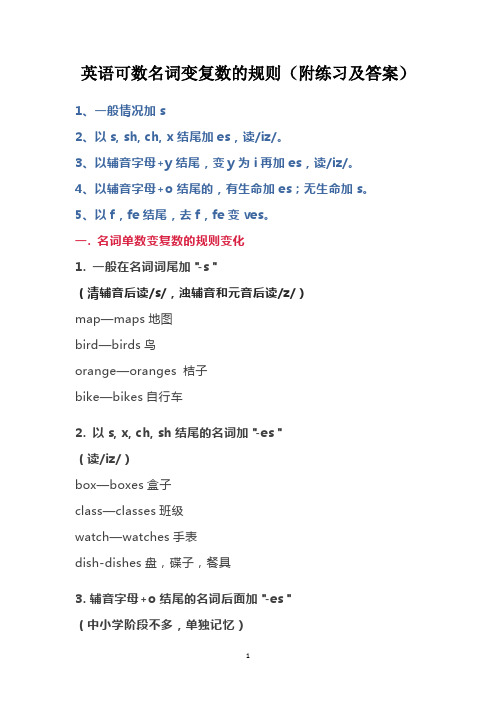
英语可数名词变复数的规则(附练习及答案)1、一般情况加s2、以s, sh, ch, x结尾加es,读/iz/。
3、以辅音字母+y结尾,变y为i再加es,读/iz/。
4、以辅音字母+o结尾的,有生命加es;无生命加s。
5、以f,fe结尾,去f,fe变ves。
一. 名词单数变复数的规则变化1. 一般在名词词尾加"-s"(清辅音后读/s/,浊辅音和元音后读/z/)map—maps地图bird—birds鸟orange—oranges 桔子bike—bikes自行车2. 以s, x, ch, sh结尾的名词加"-es"(读/iz/)box—boxes盒子class—classes班级watch—watches手表dish-dishes盘,碟子,餐具3. 辅音字母+o结尾的名词后面加"-es"(中小学阶段不多,单独记忆)tomato—tomatoes西红柿potato—potatoes土豆hero—heroes英雄negro—negroes黑人辅音字母+o结尾的名词后面加"-s"(一般为外来词或者缩写词)photo—photos相片kilo—kilos千克元音字母+o结尾的名词后面加"s" radio—radios收音机zoo—zoos动物园4. 以辅音字母加y结尾的名词,变y为i加"-es " baby—babies婴儿family—families家庭party—parties聚会以元音字母加y结尾的名词直接加"-s" boy—boys男孩toy—toys 玩具5. 以fe或f结尾的名词,把fe或f变为v加"-es"(读/vz/,数量不多,单独记忆)knife—knives小刀wife—wives妻子leaf—leaves树叶直接加-sroof—roofs房顶proof—proofs证据chief—chiefs首领两种都可以handkechief手绢—handkerchiefs / handkerchieves二. 名词单数变复数的不规则变化1. child—children 孩子foot—feet 脚tooth—teeth 牙齿mouse—mice 老鼠man—men 男人woman—women 女人注意:与man 和woman构成的合成词,其复数形式也是-men 和-women,例如:an Englishman—two Englishmen 但German不是合成词,故复数形式为Germans;Bowman是姓,其复数是the Bowmans(鲍曼一家)。
名词单数变复数的规则和练习

课时三英语名词单数变复数的规则(练习在后面,不要忘了做)一、绝大多数的可数名词的复数形式,是在该词末尾加上后辍-s。
例:friend→friends; cat→cats; style→styles; sport→sports; piece→pieces二、凡是以s、z、x、ch、sh结尾的词,在该词末尾加上后辍-es构成复数。
读音变化:统一加读[iz]。
例:bus→buses; quiz→quizzes; fox→foxes; match→matches; flash→flashes三、以辅音字母+y结尾的名词,将y改变为i,再加-es。
读音变化:加读[z]。
例:candy→candies; daisy→daisies; fairy→fairies; lady→ladies; story→stories 四、以-o结尾的名词,就加-es;读音变化:加读[z]。
例:tomato→tomatoes; potato→potatoes;bingo→bingoes反例:piano→pianos(外来词); photo→photos;五、以-f或-fe结尾的名词,多为将-f或-fe改变为-ves,但有例外。
读音变化:尾音[f]改读[vz]。
例:knife→knives; life→lives; leaf→leaves; staff→staves; scarf→scarves反例:roof→roofs六、部分单词的复数形式不变。
例:fish→fish; sheep→sheep; cattle→cattle; deer→deer;七、极少数单词,其复数形式没有任何规律。
读音变化:没有规律。
例:man→men; woman→women; child→children; person→people; ox→oxen 八、一些单数词得改头换面一番,才能变成复数词例:foot→feet; man→menmouse→mice;tooth→teeth; woman→women九、有些名词是单数、复数不分的例:deer; fish; sheep; salmon 三文鱼十、一些名词虽分单数、复数,但出现次数多的总是单数词例:clothing;furniture家具; machine机械; news; scenery风景; sugar;traffic交通十一、另一些名词则以复数词出现的机会较多例:clothes; police; shorts短裤; scissors剪刀;trousers长裤;十二、若表达具体数目,要借助数量词例:pair(对,双); suit(套); a pair of glasses; two pairs of trousers十三、另外还有一些名词,其复数形式有时可表示特别意思,例:goods货物,fishes(各种)鱼十四、除人民币元、角、分外,美元、英镑、法郎等都有复数形式。
七年级上册英语可数名词单数变复数规则及练习(含答案)
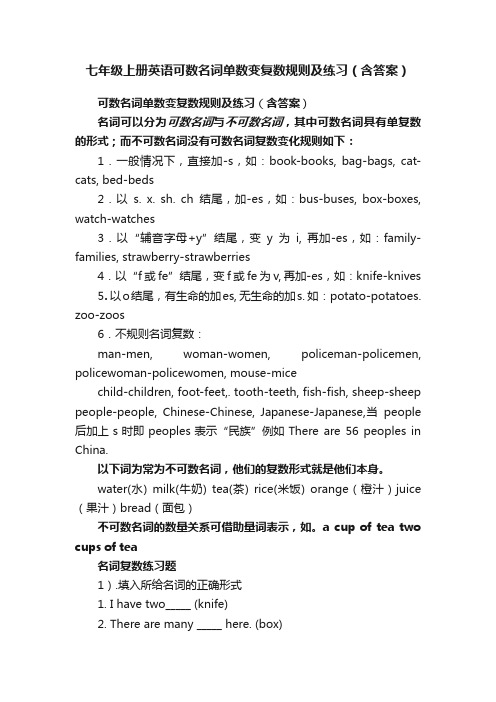
七年级上册英语可数名词单数变复数规则及练习(含答案)可数名词单数变复数规则及练习(含答案)名词可以分为可数名词与不可数名词,其中可数名词具有单复数的形式;而不可数名词没有可数名词复数变化规则如下:1.一般情况下,直接加-s,如:book-books, bag-bags, cat-cats, bed-beds2.以s. x. sh. ch结尾,加-es,如:bus-buses, box-boxes, watch-watches3.以“辅音字母+y”结尾,变y为i, 再加-es,如:family-families, strawberry-strawberries4.以“f或fe”结尾,变f或fe为v, 再加-es,如:knife-knives5.以o结尾,有生命的加es, 无生命的加s. 如:potato-potatoes. zoo-zoos6.不规则名词复数:man-men, woman-women, policeman-policemen, policewoman-policewomen, mouse-micechild-children, foot-feet,. tooth-teeth, fish-fish, sheep-sheep people-people, Chinese-Chinese, Japanese-Japanese,当people 后加上s时即peoples表示“民族”例如There are 56 peoples in China.以下词为常为不可数名词,他们的复数形式就是他们本身。
water(水) milk(牛奶) tea(茶) rice(米饭) orange(橙汁)juice (果汁)bread(面包)不可数名词的数量关系可借助量词表示,如。
a cup of tea two cups of tea名词复数练习题1).填入所给名词的正确形式1. I have two_____ (knife)2. There are many _____ here. (box)3. There are many _____ on the road. (bus)4. A few ____boys_ are drawing on the wall. (boy)5. The _childen____ are playing football now. (child)2)选择填空1. They come from different ______A. countryB. countriesC. a countryD. countrys2. How many ______ do you see in the picture?A. tomatosB. tomatoesC. tomatoD. the tomato3. There are some ______ in these _______.A.knifes…pencil-boxesB.knives…pencils-boxC.knives…pencil-boxD.knives…pencils-boxes4. There is no ______ in the plate.A. applesB. orangesC. riceD. eggs5. _______ are good for our health.A. TomatosB. TomatoesC. Tomato6. I like to eat cake with ______.A. cherriesB. cherryC.cherrys7. ______ and ______ are not friends.A. Foxs…wolfsB.Foxes wolfsC.Foxes…wolves8. Do you want to drink much ?A.a milkkks9. This is room. It’s very bi g.A.Lily and Lucy’sB.Lily’s and Lucy’sC.Lily’s and Lucy10. Do you want some for supper?A、a potatoB、potatoesC、potatos11. In autumn,you can see a lot of on the ground.A、leafB、leafsC、leaves12. My sister has two . One is old,the other is new.A、a watchB、watchsC、watches13.There on the wall .They are very beautiful.A. are photoesB. are photosC. is a photoD. is photos14. That’a art book.A. anB. aC. the D are15. There two in the box.A. is watchB. are watchesC. are watchD. is watches3)请用括号中名词的复数形式填空1. Look at those _______. (child)2. I can see a __________ standing near the door. (policeman) 3. Do you want some ________ for dinner? (potato)4.In autumn, you can see a lot of _______ on the ground.(leaf)5. He has two _______.One is blue , the other is yellow.( box) 6. Two ________ live in this building .( family )4)选择正确的词形1. How many (radioes, radios) can you see?2. There are 36 (boys, boies) in my class.3. Look at those (sheeps, sheep).4.I don’t want (a, an) old cup.5. Give me that (box, boxes), please.5)将以下单复数句进行转换1. This is a knife.___________________________________2. That is a tomato.___________________________________3. That child is very good.___________________________________4 .These are mice.___________________________________5. Those are children.___________________________________答案1.knives boxes buses boys children2.BBDCB ACBAB CCBAB3.Children policeman potatoes leaves boxes families4.Radios boys sheep an5.These are knives.Those are tomatoes.Those children are very good.This is rice.That is child.。
(完整版)小学英语名词单数变复数规则及练习
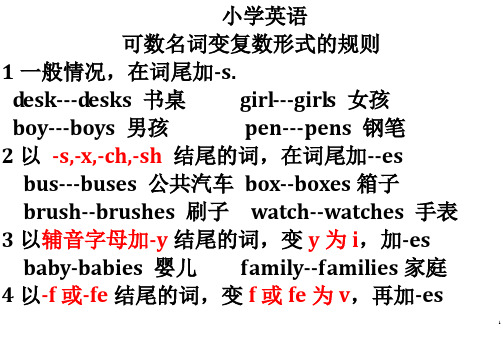
小学英语可数名词变复数形式的规则1一般情况,在词尾加-s.desk---desks 书桌girl---girls 女孩boy---boys 男孩pen---pens 钢笔2以-s,-x,-ch,-sh结尾的词,在词尾加--esbus---buses 公共汽车box--boxes箱子brush--brushes 刷子watch--watches 手表3以辅音字母加-y结尾的词,变y为i,加-es baby-babies 婴儿family--families家庭4以-f或-fe结尾的词,变f或fe为v,再加-esknife---knives刀leaf---leaves树叶5以辅音字母加-o结尾的词,有生命的,在词尾加-es;tomato---tomatoes西红柿potato--potatoes马铃薯没有生命的,在词尾加-sphoto---photos 照片6可数名词变为复数形式的不规则变化如下:foot---feet脚mouse---mice老鼠goose---geese鹅child---children孩子ox---oxen公牛m a n---m e n男人wom a n---wom e n女人Chinese--Chinese中国人deer---deer鹿fish---fish鱼sheep---sheep绵羊<一>、写出下列名词的复数形式1、orange oranges2、class classes3、text texts4、monkey monkeys5、piano pianoes5、child 7.shelf8、bed 9、country10.Family 11、toy 12、foot 13、Japanese 14、radio 15、photo 16、army 17、tomato 18、fox 19、woman 20、knife 22、sheep1)、选择填空1、There on the wall .They are very beautiful.A.are photoesB. are photosC. is a photoD. is photos2. This kind of car made in Shanghai.A. is B .are C .were D .has3. There are four and two in the group.A. Japanese, Germen B Japaneses, GermenC. Japanese,GermanD.Japanese, Germans4. That’a art book.A. anB. aC. the D are5. The boys have got already.A. two breadB. two breadsC. two pieces of breadD. two piece of bread6. The old man wants .A. six boxes of applesB. six boxes of appleC. six box of applesD. six boxs of apples7. There some in the river.A. is ,fishB. are, fishsC. is, fishsD. are ,fish8. There two in the box.A. is watchB. are watchesC. are watchD. is watches9. We should clean twice a day.A .our tooth B. our toothsC.teethD.our teeth10.The _____ meeting room is near the reading room.A.teacherB.teacher’sC.teachers’D.teachers11. In Britain _____ are all painted red.A.letter boxesB.letters boxesC.letter boxD.letters box2)选择填空1.They come from different ______A. countryB. countriesC. a countryD. countrys2.How many ______ do you see in the picture?A. tomatosB. tomatoesC. tomatoD. the tomato3. They are______.A . woman teachers B. women teachersB.women teacher D. woman teacher4. Would you like _______ ,please?A. two glass of waterB. two glasses of waterC.C. two glass of watersD.two glasses of waters5.Most of ______ live in _______.A.Germans, GermanB. German, GermenB.Germen, Germany D. Germans, Germany6.There are some ______ in these _______.A.knifes pencil-boxesB.knives pencils-boxC.knives pencil-boxD.knives pencils-boxes7. ______ like ______ by air.A. Greens, travellingB. The Green, travelingC. The Greens, travelD. The Greens, traveling8.I wonder why ______ are interested in action films (武打片).A.the peopleB. peopleB.peoples D. the peoples9.There is no ______ in the plate.A.applesB. orangesC. riceD. eggs3).填入所给名词的正确形式1.I have two_____ (knife)2.There are many _____ here. (box)3.There are many _____ on the road. (bus)4.A few _____ are drawing on the wall. (boy)5.The _____ are playing football now. (child) 4)写出下列名词的复数形式。
英语名词单复数变化规律及练习题

名词单数变复数规则规则变化1)一般情况下加-s如book--books(书)desk--desks(书桌)2)以s,x,ch,sh结尾加-es如box--boxes(盒子)bus--buses(公共汽车)brush--brusheswatch--watches注意①以th结尾加-s,month--months②stomach--stomachs3)以辅音字母+结尾,变y为i再加-es。
如city--cities(城市)country--countries(国家)baby-babies婴儿family--families家庭注意以元音+y,直接加s。
如:day--days(天),boy--boys(男孩)4)以f或fe结尾,复数变f或fe为v再加-es如knife-knives(书),half-halves(一半)leaf---leaves树叶(thief,wife,life,shelf,knife,leaf,self,half,wolf)注意①有少数词后直接加s,如roof-roofs(屋顶)5)以o结尾分2类(1)o结尾的加-es如tomato-tomatoes(西红杮)potato-potatoes(土豆)hero-heroes(英雄)(2)o结尾名词的加-s如piano-pianos(钢琴),zoo-zoos(动物园)photo-photos(照片),kangaroo-kangaroos(袋鼠)kilo-kilos(千克)注意zero两种方式都可:zero-zeros或zeroes(零)不规则变化1)元音字母发变化。
如man--men(男人),woman--women(妇女)tooth--teeth(牙齿),foot--feet(脚)mouse--mice(老鼠),policeman--policemen(警察)policewoman--policewomen(女警察)2)词尾发生变化。
如child--children(小孩),ox--oxen(公牛)3)单、复数形式相同。
可数名词单数变复数规则及练习含答案
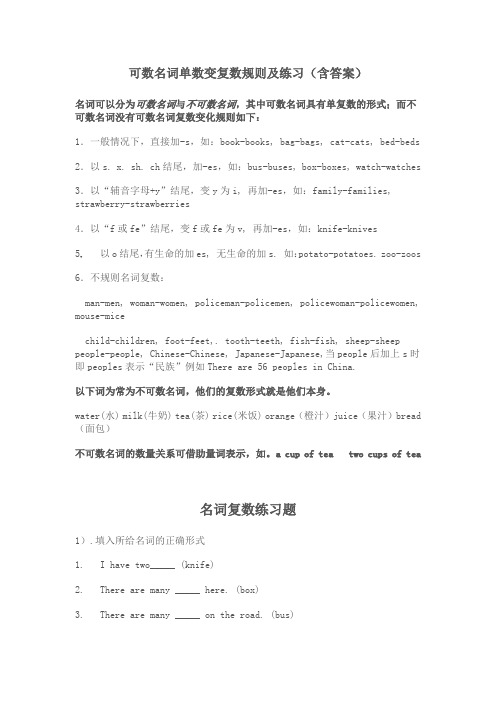
可数名词单数变复数规则及练习(含答案)名词可以分为可数名词与不可数名词,其中可数名词具有单复数的形式;而不可数名词没有可数名词复数变化规则如下:1.一般情况下,直接加-s,如:book-books, bag-bags, cat-cats, bed-beds 2.以s. x. sh. ch结尾,加-es,如:bus-buses, box-boxes, watch-watches3.以“辅音字母+y”结尾,变y为i, 再加-es,如:family-families, strawberry-strawberries4.以“f或fe”结尾,变f或fe为v, 再加-es,如:knife-knives5.以o结尾,有生命的加es, 无生命的加s. 如:potato-potatoes. zoo-zoos 6.不规则名词复数:man-men, woman-women, policeman-policemen, policewoman-policewomen, mouse-micechild-children, foot-feet,. tooth-teeth, fish-fish, sheep-sheep people-people, Chinese-Chinese, Japanese-Japanese,当people后加上s时即peoples表示“民族”例如There are 56 peoples in China.以下词为常为不可数名词,他们的复数形式就是他们本身。
water(水) milk(牛奶) tea(茶) rice(米饭) orange(橙汁)juice(果汁)bread (面包)不可数名词的数量关系可借助量词表示,如。
a cup of tea two cups of tea名词复数练习题1).填入所给名词的正确形式1. I have two_____ (knife)2. There are many _____ here. (box)3. There are many _____ on the road. (bus)4. A few ____boys_ are drawing on the wall. (boy)5. The _childen____ are playing football now. (child)2)选择填空1. They come from different ______A. countryB. countriesC. a countryD. countrys2. How many ______ do you see in the picture?A. tomatosB. tomatoesC. tomatoD. the tomato3. There are some ______ in these _______.…pencil-boxes …pencils-box…pencil-box …pencils-boxes4. There is no ______ in the plate.A. applesB. orangesC. riceD. eggs5. _______ are good for our health.A. TomatosB. TomatoesC. Tomato6. I like to eat cake with ______.A. cherriesB. cherry7. ______ and ______ are not friends.A. Foxs…wolfs wolfs …wolves8. Do you want to drink much ?milk9. This is room. It’s very big.and Lucy’s’s and Lucy’s’s and Lucy10. Do you want some for supper?A、a potatoB、potatoesC、potatos11. In autumn,you can see a lot of on the ground.A、leafB、leafsC、leaves12. My sister has two . One is old,the other is new.A、a watchB、watchsC、watcheson the wall .They are very beautiful.A. are photoesB. are photosC. is a photoD. is photos14. That’a art book.A. anB. aC. the D are15. There two in the box.A. is watchB. are watchesC. are watchD. is watches 3)请用括号中名词的复数形式填空1. Look at those _______. (child)2. I can see a __________ standing near the door. (policeman)3. Do you want some ________ for dinner? (potato)4. In autumn, you can see a lot of _______ on the ground.(leaf) 5. He has two is blue , the other is yellow.( box)6. Two ________ live in this building .( family )4)选择正确的词形1. How many (radioes, radios) can you see?2. There are 36 (boys, boies) in my class.3. Look at those (sheeps, sheep).4.I don’t want (a, an) old cup.5. Give me that (box, boxes), please.5)将以下单复数句进行转换1.This is a knife.___________________________________2.That is a tomato.___________________________________3.That child is very good.___________________________________4 .These are mice.___________________________________5.Those are children.___________________________________答案1.knives boxes buses boys children2.BBDCB ACBAB CCBAB3.Children policeman potatoes leaves boxes families4.Radios boys sheep an5.These are knives.Those are tomatoes.Those children are very good.This is rice.That is child.。
名词单复数变化规则练习

名词单复数变化规则练习在英语学习中,名词的单复数变化是一个重要的语法知识点。
掌握好名词单复数的变化规则,对于正确使用英语、准确表达意思至关重要。
下面我们就来详细地学习和练习一下名词单复数的变化规则。
一、一般规则1、大多数名词在词尾直接加“s”比如:book books,pen pens,car cars 。
这是最常见也最容易理解的一种变化方式。
2、以“s”“x”“ch”“sh”结尾的名词,在词尾加“es”例如:bus buses,box boxes,watch watches,brush brushes 。
需要注意的是,这种变化是为了保持读音的顺畅。
3、以“辅音字母+y”结尾的名词,把“y”变为“i”,再加“es”像:city cities,baby babies,factory factories 。
但如果“y”前是元音字母,则直接加“s”,如:boy boys,day days 。
4、以“f”或“fe”结尾的名词,把“f”或“fe”变为“v”,再加“es”常见的有:leaf leaves,knife knives,wife wives 。
不过也有一些例外,如:roof roofs 。
二、不规则变化1、单复数同形有些名词的单复数形式是相同的,比如:sheep sheep,deer deer,fish fish (表示鱼的种类时复数为 fishes )。
2、改变元音字母例如:man men,woman women,foot feet,tooth teeth 。
3、其他特殊变化child children,mouse mice 。
三、练习题目为了更好地掌握名词单复数的变化规则,我们来做一些练习题。
(一)写出下列名词的复数形式1、 bag ______2、 class ______3、 glass ______4、 fox ______5、 dish ______6、 baby ______7、 city ______8、 story ______9、 leaf ______10、 knife ______(二)用所给名词的正确形式填空1、 There are five ______ (box) on the table2、 The ______ (man) are working hard3、 I have two ______ (watch)4、 How many ______ (child) are there in the room?5、 She has three ______ (foot)四、答案解析(一)1、 bags2、 classes3、 glasses4、 foxes5、 dishes6、 babies7、 cities8、 stories9、 leaves10、 knives(二)1、 boxes2、 men3、 watches4、 children5、 feet通过以上的学习和练习,相信大家对名词单复数的变化规则有了更深入的理解和掌握。
小学名词变复数题目及答案

小学名词变复数题目及答案这份文档旨在帮助小学生掌握英语名词复数的构成规则,并通过大量的练习题巩固所学知识。
文档包含了各种类型的名词复数练习,并附有详细的答案解析,力求全面覆盖小学阶段名词复数的学习内容。
一、名词复数构成规则详解英语名词的复数形式通常是在单数名词后加“-s”,但也有许多例外情况。
以下详细讲解各种规则及例外情况:1. 规则变化:加“-s”大多数名词的复数形式是在单数名词后直接加“-s”,例如:•book - books (书)•cat - cats (猫)•dog - dogs (狗)•pen - pens (钢笔)•tree - trees (树)•car - cars (汽车)•girl - girls (女孩)•boy - boys (男孩)•apple - apples (苹果)•banana - bananas (香蕉)2. 规则变化:加“-es”以下几种情况需要在单数名词后加“-es”:•以s, x, ch, sh结尾的名词:这些字母结尾的名词发音比较困难,直接加s会显得不协调,所以要加-es。
o bus - buses (公共汽车)o box - boxes (盒子)o watch - watches (手表)o brush - brushes (刷子)o class - classes (班级)o dish - dishes (盘子)•以辅音字母+y结尾的名词:需要将y改为i再加-es。
o baby - babies (婴儿)o city - cities (城市)o country - countries (国家)o family - families (家庭)o lady - ladies (女士)o story - stories (故事)•以o结尾的名词:部分以o结尾的名词加-es,部分加-s,需要记忆。
o potato - potatoes (土豆)o tomato - tomatoes (西红柿)o hero - heroes (英雄)o echo - echoes (回声)o volcano - volcanoes (火山)o但是:photo - photos (照片), radio - radios (收音机), piano - pianos (钢琴) 等则直接加-s3. 不规则变化一些名词的复数形式变化不规则,需要单独记忆:•man - men (男人)•woman - women (女人)•child - children (孩子)•foot - feet (脚)•tooth - teeth (牙齿)•mouse - mice (老鼠)•ox - oxen (公牛)•goose - geese (鹅)4. 特殊情况•一些名词单复数同形:例如:sheep (绵羊), deer (鹿), fish (鱼), Chinese (中国人), Japanese (日本人) 等。
名词变复数的规则及习题
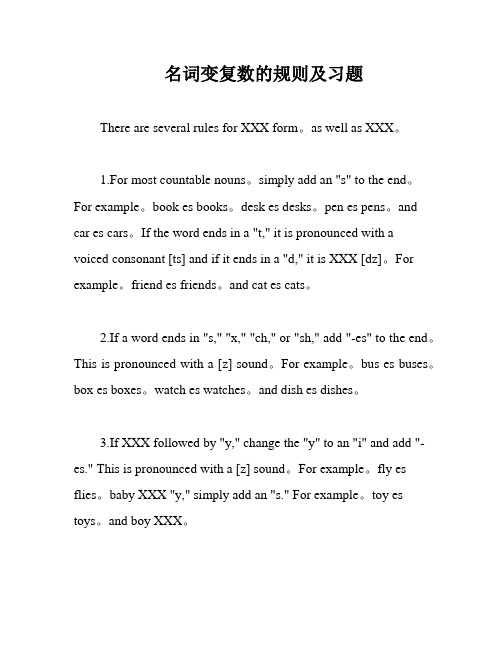
名词变复数的规则及习题There are several rules for XXX form。
as well as XXX。
1.For most countable nouns。
simply add an "s" to the end。
For example。
book es books。
desk es desks。
pen es pens。
and car es cars。
If the word ends in a "t," it is pronounced with a voiced consonant [ts] and if it ends in a "d," it is XXX [dz]。
For example。
friend es friends。
and cat es cats。
2.If a word ends in "s," "x," "ch," or "sh," add "-es" to the end。
This is pronounced with a [z] sound。
For example。
bus es buses。
box es boxes。
watch es watches。
and dish es dishes。
3.If XXX followed by "y," change the "y" to an "i" and add "-es." This is pronounced with a [z] sound。
For example。
fly es flies。
baby XXX "y," simply add an "s." For example。
可数名词单数变复数规则及练习含答案
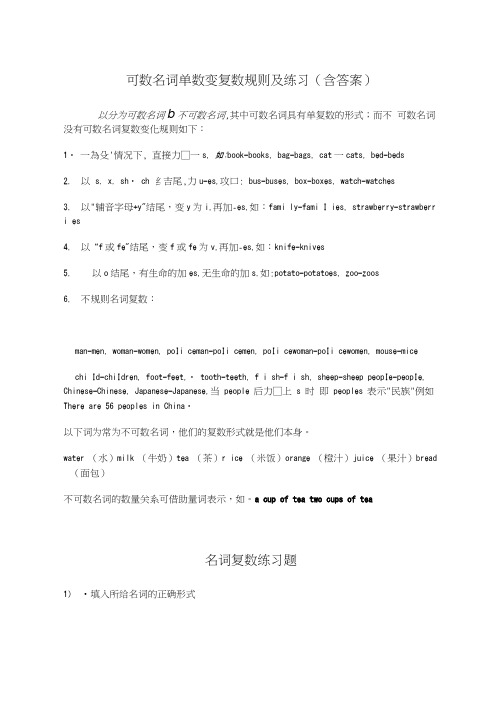
可数名词单数变复数规则及练习(含答案)以分为可数名词b不可数名词,其中可数名词具有单复数的形式;而不可数名词没有可数名词复数变化规则如下:1・一為殳'情况下, 直接力□一s, 如:book-books, bag-bags, cat一cats, bed-beds2.以s. x. sh・ ch 纟吉尾,力u-es,攻口: bus-buses, box-boxes, watch-watches3.以"辅音字母+y"结尾,变y为i,再加-es,如:fami ly-fami I ies, strawberry-strawberri es4.以“f或fe"结尾,变f或fe为v,再加-es,如:knife-knives5.以o结尾,有生命的加es,无生命的加s.如:potato-potatoes, zoo-zoos6.不规则名词复数:man-men, woman-women, poIi ceman-poIi cemen, poIi cewoman-poIi cewomen, mouse-micechi Id-chiIdren, foot-feet,・ tooth-teeth, f i sh-f i sh, sheep-sheep peopIe-peopIe, Chinese-Chinese, Japanese-Japanese,当people 后力□上s 时即peoples 表示"民族"例如There are 56 peoples in China・以下词为常为不可数名词,他们的复数形式就是他们本身。
water (水)milk (牛奶)tea (茶)r ice (米饭)orange (橙汁)juice (果汁)bread (面包)不可数名词的数量关系可借助量词表示,如。
a cup of tea two cups of tea名词复数练习题1)•填入所给名词的正确形式1. I have two (knife)2. There are many here.(box)3. There are manyon the r oad ・(bus)4. A fewboysare drawingon the waI I ・(boy)5.The 一chi I den _ are playing footba I I now ・(child) 2) 选择填空They come from d i fferent8. Do you want to dr i nk much1. A. countryB. countriesC ・ a countryD. countrys2. How many do you see in the picture A. tomatos B. tomatoes C ・ tomatoD. the tomato3. There are somei n these •••penc i I -boxes•••penc i I s -box •••penci I —box •••penc i I s -boxes4. There i s noA. B. oranges C ・ r ice D. eggs5.are good forour hea I th.A. TomatosB. Tomatoes C ・ Toma to6.A. cherriesB. cherry7. _____andare not friends. A. Foxs ・・・wo I fswo I fs•••wo I vesIike to eat cake withmilk 9.This is _____________________ room ・ It' s very big.3)请用括号中名词的复数形式填空3. Do you want somefor d i nner (potato)4. In autumn, you can see a lot of5.He has two i s bIue , the other i s ye I low ・(box)and Lucy' s s and Lucy' ss and Lucy10. Do you want some _____________________ for supperA 、 a potatoB 、 potatoesC 、 potatos11.In autumn,on the ground.A 、 leafB 、 IeafsC 、 I eaves 12. My s i ster has twoOne is old, the other is new.A 、 a watchB 、 watchsC 、 watches _____________ o n the waI I・ They are verybeaut i fuI ・A. are pho toesB. are photosC. is a pho toD. is photos14. That' aartbook.A. anB. aC. theD are15. There twothe box.A. iswatchB. are v/atchesC. are watchD. iswatches1. Look at those・(chi Id) 2.can see astanding nearthe door ・ (policeman)on the ground ・(leaf)you can see a6.Two Iive in this bui Iding ・(family ) 4)选择正确的词形1.How many (radioes, radios) can you see2.There are 36 (boys, boies) i n my cI ass・3.Look at those (sheeps, sheep)・<4.I don' t want (a, an) old cup・5.Give me that (box, boxes), pI ease・5)将以下单复数句进行转换1 ・ This is a knife・答案1. kni ves boxes buses boys ch iIdren2. BBDCB ACBAB CCBAB3.ChiIdren poI iceman potatoes leaves boxes famiIi es4. Rad i os boys sheep an5. These are knives.Those are tomatoes.Those chi Idren are very good.Thi s i s r ice.That is chi Id.。
名词变复数规则及练习
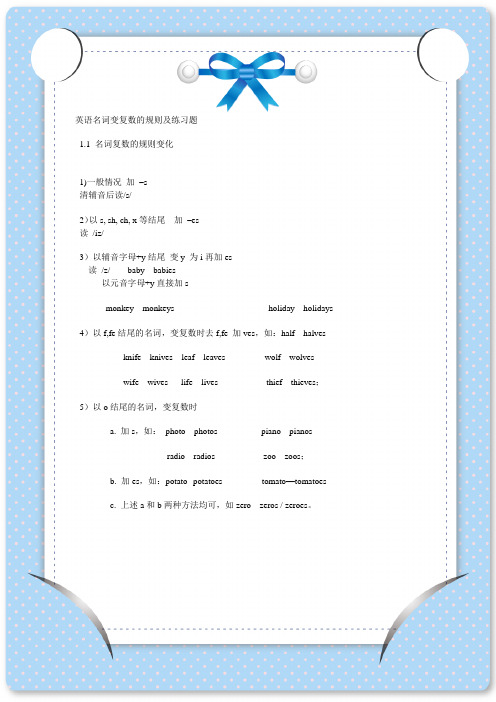
英语名词变复数的规则及练习题1.1 名词复数的规则变化1)一般情况加–s ________ ________ ________ ________ ________清辅音后读/s/2)以s, sh, ch, x等结尾加–es _______ ________ ________ ________ ________ 读/iz/3)以辅音字母+y结尾变y 为i再加es读/z/ baby---babies ________ ________ ________ ________以元音字母+y直接加smonkey---monkeys ________ ________ holiday---holidays4)以f,fe结尾的名词,变复数时去f,fe 加ves,如:half---halvesknife---knives leaf---leaves wolf---wolveswife---wives life---lives thief---thieves;5)以o结尾的名词,变复数时a. 加s,如:photo---photos piano---pianosradio---radios zoo---zoos;b. 加es,如:potato--potatoes tomato—tomatoes _________c. 上述a和b两种方法均可,如zero---zeros / zeroes。
1.2 名词复数的不规则变化1)child---children foot---feet tooth---teeth)mouse---mice man---men woman---women注意:由一个词加man 或woman构成的合成词,其复数形式也是-men 和-women,如an Englishman,two Englishmen, women teachers, men doctors.但German不是合成词,故复数形式为Germans;2)单复同形,如deer,sheep,fish,Chinese,Japanese ,people,yuan,four jin等。
英语名词单数变复数的语法规则及练习题含答案
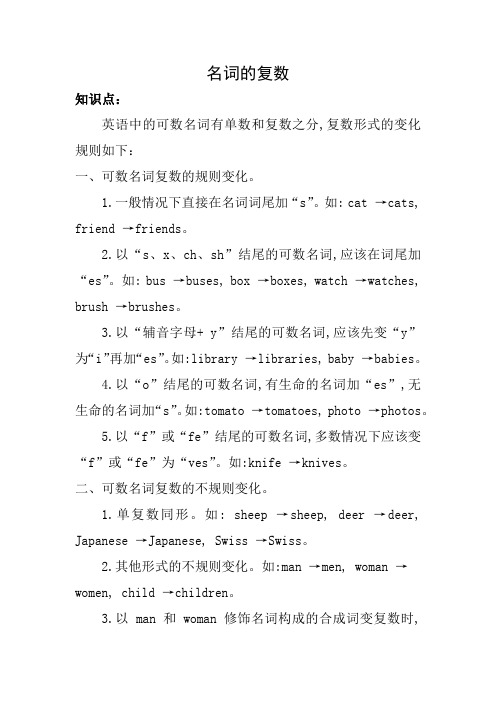
名词的复数知识点:英语中的可数名词有单数和复数之分,复数形式的变化规则如下:一、可数名词复数的规则变化。
1.一般情况下直接在名词词尾加“s”。
如: cat →cats, friend →friends。
2.以“s、x、ch、sh”结尾的可数名词,应该在词尾加“es”。
如: bus →buses, box →boxes, watch →watches, brush →brushes。
3.以“辅音字母+ y”结尾的可数名词,应该先变“y”为“i”再加“es”。
如:library →libraries, baby →babies。
4.以“o”结尾的可数名词,有生命的名词加“es”,无生命的名词加“s”。
如:tomato →tomatoes, photo →photos。
5.以“f”或“fe”结尾的可数名词,多数情况下应该变“f”或“fe”为“ves”。
如:knife →knives。
二、可数名词复数的不规则变化。
1.单复数同形。
如: sheep →sheep, deer →deer, Japanese →Japanese, Swiss →Swiss。
2.其他形式的不规则变化。
如:man →men, woman →women, child →children。
3.以 man 和 woman 修饰名词构成的合成词变复数时,两个词都要变化。
如: woman doctor →women doctors。
三、s 在名词词尾的读音规则。
1.在/p/、/t/、/k/、/f/等清辅音后读作/s/,如: cups, hats, cakes, roofs。
2.在/s/、/z/、/ ʃ /、/ tʃ /等音素后读作/ɪz/,如: glasses, faces, roses。
3.在其他情况下读作/z/,如:days, cities, knives。
4.th在词尾原本应该读作/θ/,加 s后则多数读作/ǒz/。
如: mouth→ mouths, path →paths;但是也有不变化的情况,如: month→months;ninth→ninths; youth →youths。
名词变复数的规则及习题

名词变复数一.名词变复数规则变化及发音:1、绝大多数的可数名词在词尾加上s ;eg:book→books;desk→desks;pen→pens;car→cars s遇t读浊辅音[ts],遇d读清辅音[dz] eg:friend→friends; cat→cats;2.、以s、x、ch、sh结尾的单词,在该词末尾加上-es;读音规则:读[iz];eg:bus→buses; box→boxes; watch→watch ches; dish→dishes3、以辅音字母+y结尾的名词,要把y变为i,再加-es;读音规则:读[z]。
eg:fly→flies; b ab y→b abies; 元音字母加y结尾的单词直接加s;eg:toy→toys;boy→boys;4、以-f或-fe结尾的名词,要将-f或-fe变为-v,再加es;读音规则:读[vz];eg:knife→knives;leaf→leaves;5、以-o结尾的名词,初级阶段只有三个单词要加-es,其余都加-s;读音规则:读[z]。
eg:tomato→tomatoes西红柿; potato→potatoes土豆; hero→h eroes英雄; Negro—Negroes 口诀:“黑人英雄喜欢吃土豆和西红柿”其余eg:zoo→zoos; hippo→hippos;二.名词变复数不规则变化:1.单词内部发生变化:口诀“oo常常变ee,男人女人a变e”eg:foot→feet脚;tooth→teeth牙齿;man→men男人;woman→women女人;2.单复数相同:“羊鱼小鹿无变化,单数复数是一家”eg:sheep→sheep绵羊;fish→fish鱼;deer→deer鹿;3.不规则变化:child→c hildren孩子;mouse→mice老鼠;German→Germans德国人;4“某国人”的复数有三种类型:口诀“中日不变,英法变,其它S加后边”(1)Chinese, Japanese单数复数同形,不需加s;(2)Englishman, Frenchman, Dutchman(荷兰人)复数要把man 变为men;(3)其他各国人以–an, -ian收尾的均直接加s。
(完整版)小学英语名词变复数专项练习题
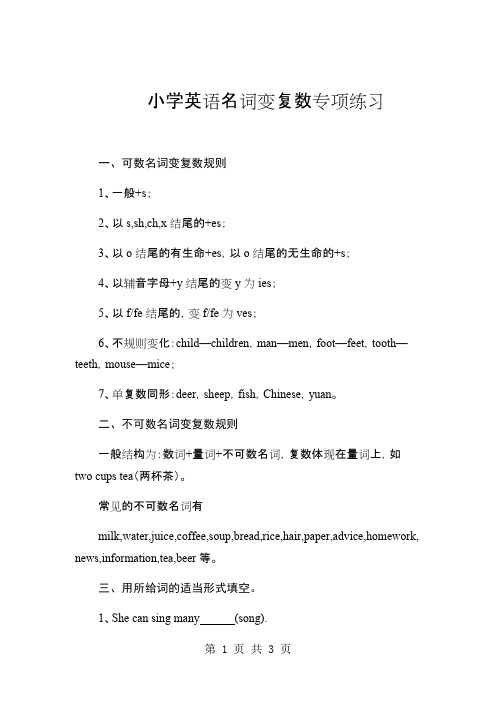
小学英语名词变复数专项练习一、可数名词变复数规则1、一般+s;2、以s,sh,ch,x结尾的+es;3、以o结尾的有生命+es,以o结尾的无生命的+s;4、以辅音字母+y结尾的变y为ies;5、以f/fe结尾的,变f/fe为ves;6、不规则变化:child—children,man—men,foot—feet,tooth—teeth,mouse—mice;7、单复数同形:deer,sheep,fish,Chinese,yuan。
二、不可数名词变复数规则一般结构为:数词+量词+不可数名词,复数体现在量词上,如two cups tea(两杯茶)。
常见的不可数名词有milk,water,juice,coffee,soup,bread,rice,hair,paper,advice,homework, news,information,tea,beer等。
三、用所给词的适当形式填空。
1、She can sing many (song).2、Peter have three (e-friend).3、He’s six (year) old.4、Lily has gone to several foreign (country).5、Wang Bing could speak different (language).6、We have eight (lesson) every day.7、Sam and Billy talk about their (hobby).8、I have lots of good (friend) in Nanjing.9、Are there any (student) in the classroom?10、Tom has a few nice story (book).11、Millie’s mother often makes (cake) for us.12、Ted has hundreds of (toy) at home.13、Jack always has lots of good (idea).14、Our farm has fifty-four (sheep) this year.15、My parents are English (teacher).16、Teacher Wu often tells some funny (story) in class.17、All of the people here are (writer).18、The ground is full of (leave).19、The two (thief) were caught by the police.20、We all like (hero).21、He loves eating (mango) very much.22、These (tomato) are very fresh.23、We have few (potato) left.24、There are so many (child) in the kindergarten.25、Many students in this school are (Chinese).26、The book is six (yuan).27、Lily has two (glass) of milk.28、There (be )some bread on the table.29、Do you like having some (coffee).30、I have two (bowl) of rice everyday.。
名词单复数变化(规则变化及练习)

名词单复数变化(一)可数名词单复数规则变化一、理论知识:1. 一般情况下,名词变复数直接加____________如: book ______ _______ car _______ _______ chair _______ _____friend ______ ______ desk ______ _____ girl ______ ______2. 以___________、___________、___________、___________ 结尾的名词加_es 变成复数如: bus ________ ________ watch ________ ________brush ________ ________ box ________ ________bush ________ ________ fox ________ ________3. 以f或fe 结尾的名词,变复数为,变__________为__________ 再加__________ 如:wife ______ ______ shelf ______ _______ wolf ______ ______leaf ________ ________ life ________ ________口诀:小偷的妻子一生中只注意架子上的小刀,树叶和自己的半匹狼thief wife life shelf knife, leaf, self half wolf 4. 以“辅音字母+y”结尾的,名词,变复数为:________________________________如: factory ________ ________ country ________ ________city ________ ________ story ________ ________5. 以“原音字母+y”结尾的名词,变复数为: ________________________________如: boy _______ ______ day ______ ______ toy ______ ______6. 以字母“o”结尾的名词,一般情况下变复数加________________如: photo ______ ______ zoo ______ ______ radio ______ ______7. 有些以“o” 结尾的名词,变复数加________________如: potato _______ _______ tomato ________ ________ hero ________ ________ Negro ________ ________ echo ________ ________(二)可数名词的不规则变化一、理论知识1. 变单词本身字母如:foot ________ ________ tooth ________ ________ goose ________ ________ man ________ ________ woman ________ ________ mouse ________ ________ child ________ ________ ox ________ ________2. 单复数同行sheep ________ ________ deer ________ ________ fish ________ ________ Chinese________ ________ Japanese ________ ________ Swiss ________ ________ 口诀:中国人,日本人还有瑞士人都喜欢吃羊,鹿,鱼Chinese Japanese Swiss sheep deer fish4. 国人的变化(1) 中、日不变Chinese___________ ___________ Japanese___________ ___________(2) 英、法a 变eEnglishman ___________ ___________ Frenchman ___________ ___________ (3) 其他一律加sGerman ___________ ___________ American ___________ ___________Australian ___________ ___________ Canadian ___________ ___________(口诀:中日不变,英法变,其他一律加s)5.以下单词是集体名词,本身就只有复数的形式people 人们glasses 眼镜clothes 衣服police 警察trousers 裤子scissors 剪刀family 家人thanks 感谢compass 圆规shoes 鞋子socks 袜子写出下列名词的复数形式,并写出各词的汉语意思watch ______ ______ boy ______ ______ shoe ______ ______ student ______ ______ girl ______ ______ leg ______ ______ cup ______ ______ train ______ ______ shelf ______ ______ fox ______ ______ brush ______ ______ class ______ ______ map ______ ______ roof ______ ______ tool ______ ______ tree ______ ______ potato ______ ______ piano ______ ______ holiday ______ ______ Negro ______ ______ chief ______ ______ mouth ______ ______ piece ______ ______ year ______ ______ way ______ ______ body ______ ______ banana ______ ______ watch ______ ______ factory ______ ______ library ______ ______ chair ______ ______ tomato ______ ______ brush ______ ______ monkey ______ ______ dress ______ ______ match ______ ______ orange ______ ______ wife ______ ______ belief ______ ______ party ______ ______ Chinese ______ ______ hero ______ ______ park ______ ______ railway ______ ______ word ______ ______ reef ______ ______ Frenchman ______ ______ sheep ______ ______ tooth ______ ______ photo ______ ______ university ______ ______ brief ______ ______ glass ______ ______ teacher ______ ______ hand ______ ______ foot ______ ______ mouse ______ ______ shirt ______ ______ apple ______ ______ deer ______ ______ German ______ ______ Englishman ______ ______ fish ______ ______ Negro ______ ______ family ______ ______ skirt ______ ______ piano ______ ______ month ______ ______ serf ______ ______ giraffe ______ ______ radio ______ ______ chimney ______ ______ train ______ ______ station ______ ______ house ______ ______ classroom ______ ______ office ______ ______ monkey ______ ______ baby ______ ______ leaf ______ ______ kite ______ ______ knife ______ ______ proof ______ ______ reef ______ ______ story ______ ______ thief ______ ______ brother ______ ______名词单复数变化练习用所给词的适当形式填空1. My parents are all ___________ (teacher).2. The desk has four ___________ (leg).3. There are many ___________ (sheep) on the hill.4. A dog has four ___________ (foot).5. There are twelve ___________ (month) in a year and seven ___________ (day) in a week.6. How many ___________ (tomato) are there in the fridge?7. There are three ___________ (apple) and two ___________ (egg) on the plate.8. These black ___________ (mouse) look terrible.9. There are four ___________ (person) in my family.10. We are ___________ (Chinese).They are ___________ (American).11. The little boy has four ___________ (tooth).12. Lily and Lucy are ___________ (Japanese).13. Why do you bring two ___________ (knife) with you?14. Jim and Mary are from different ___________ (country), they are four ___________ (class) from Monday to Friday.15. There are many ___________ (tree) on either side of the street.16. There are fifty ___________ (state) in the USA.17. Can you another two ___________ (cake)?18. How many ___________ (family) are there in the village?19. Seven ___________ (student) are taking ___________ (photo) over there.20. I have four ___________ (watch).21. The ___________ (German) are going to Paris.22. These ___________ (child) are ___________ (Englishman).23. Shanghai is one of the biggest ___________ (city) in China.24. The ___________ (leaf) turn yellow in autumn.25. There are four ___________ (season) in a year and three ___________ (month) in a season.26. There are thirty ___________ (boy) and twenty ___________ (girl) in the class.27. I have one _________ (mouth), two ________ (eye), and two _________ (foot).28. The ___________ (policeman) are in the station.29. We took many ___________ (photo) in the park.30. There are not many ___________ (fish) in the river.31. I want to be a ___________ (scientist) in the future.32. We have many ___________ (book) on the desk.33. This pair of ___________ (glass) is too small for me.34. Please give my best ___________ (wish) for your parents.35. These ___________ (photo) are old.36. Those ___________ (child) are lovely.37. The ___________ (hero) are ___________ (German).38. There are two ___________ (factory) near my home and two thirds of the workers are___________ (Chinese).39. The ten ___________ (question) are hard to work out.40. There are twenty-four ___________ (hour) in a day.41. The two ___________ (man) are ___________ (Englishman).42. There are many ___________ (sheep) and ___________ (deer) on the grass.43. Here are three ___________ (goose). There are many ___________ (ox).44. I am thirsty. Please give me four ___________ (glass) of drink.45. There are a lot of ___________ (bus) in the street.46. My parents have two ___________ (child).47. The old man’s sisters are ___________ (Australian).48. The little girl has two ___________ (pen).49. I received two ___________ (letter) yesterday.50. They have many ___________ (child), but none of them likes to wash ___________ (dish).51. Six of them are ___________ (worker), but Mr. Liu and Mr. Li are ___________ (postman).52. How many ___________ (radio) are there in the room?53. This passage has four ___________ (part).54. The two ___________ (boy) are my ___________ (friend).55. These ___________ (student) are our ___________ (classmate).补充词汇:best 最好的friend 朋友from 来自question 问题big 大的small 小的police 警察fifty 五十Monday 星期一Friday 星期五side 边either 两者之一letter 信knife 小刀twelve 十二person 人future 将来scientist 科学家work out 算出lovely 可爱的postman 邮递员part 部分radio 收音机classmate 同学parents 父母亲bring 带来station 车站factory 工厂leg 腿different 不同的leaf 树叶third 第三hill 小山country 国家yellow 黄色的grass 草地these 这些cake 蛋糕autumn 秋天thirsty 渴的those 那些state 州season 季节receive 收到fridge 冰箱village 村庄thirty 三十yesterday 昨天。
名词变复数及练习题
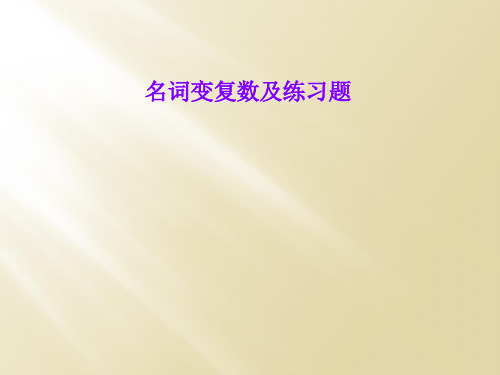
5. The boys have got aClready.
A.two bread
B. two breads
C. two pieces of bread D. two piece of bread
6. The old man wants A. A. six boxes of apples B. six boxes of apple C. six box of apples D. six boxs of apples
7. There D some in the river. A. is ,fish B. are, fishs C. is, fishs D. are ,fish
8. There Btwo in the box. A. is watch B. are watches C. are watch D. is watches
Russian → Russians, Arab → Arabs, German → Germans 等
英语名词单数变复数规则和相关练习题及答案

名词单数变复数规则1.一般情况下,直接加s如:apple-apples pig-pigs book-books2.以s、sh、ch、x结尾的名词,加es如:bus-buses(公车) class-classes(班级)watch-watches(手表) box-boxes(盒子) fox-foxes(狐狸) 3.以元音字母+y结尾的名词,直接加s如:boy-boys(男孩) toy-toys(玩具)4.以辅音字母+y结尾的名词,去y改ies如:family-families(家庭) strawberry-strawberries(草莓)5.以”o"结尾的名词:(1)加es,如:potato-potatoes tomato-tomatoes(2)加s .如:photo-photos(照片)8.单复同形的名词:(1)f ish-fish(鱼)sheep-sheep(绵羊)(2)不可数名词,如:water(水),rice(米饭),milk(牛奶),juice(果汁),bread(面包),tea(茶),orange(橙汁)9.不规则变化的名词:(1)m an-men,woman-women (记忆方法,“男人女人”,“a”变“e”.)(2)c hild-children(孩子)(3)m ouse-mice(老鼠)(4)I-we (我-我们) you-you (你-你们)he/she/it-they (他/她/它-他们)this-these(这个-这些) that-those(那个-那些)am/is –are (是) has-have(有)(5)将“oo”改为“ee"的名词如:tooth-teeth(牙) foot-feet(脚)课堂练习一.出下列各词的复数。
1.mouse______2.this_______3.watch_______4.child_______5.photo______6.diary_______7.boy________ 8.foot________ 9.fish_______11.man________ 12.firman___14.deer______ 15.I ____16.tomato______ 17.brush_____ 18.glass____二、选择题。
名词变复数规律及练习题
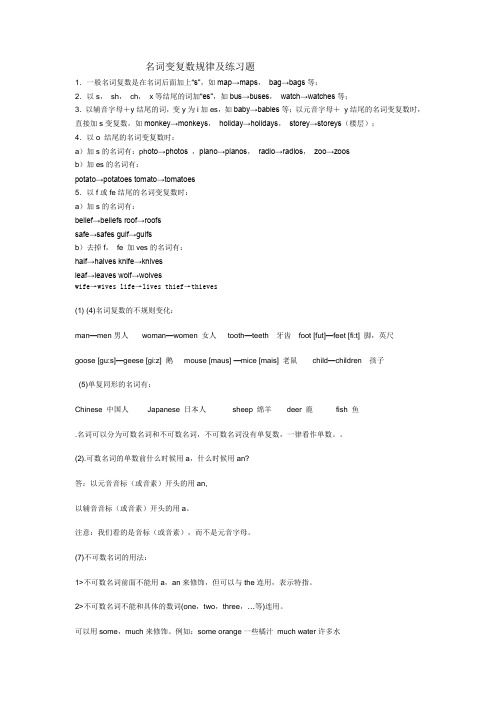
名词变复数规律及练习题1.一般名词复数是在名词后面加上“s”,如map→maps,bag→bags等;2.以s,sh,ch,x等结尾的词加“es”,如bus→buses,watch→watches等;3.以辅音字母+y结尾的词,变y为i加es,如baby→babies等;以元音字母+y结尾的名词变复数时,直接加s变复数,如monkey→monkeys,holiday→holidays,storey→storeys(楼层);4.以o 结尾的名词变复数时:a)加s的名词有:ph oto→photos ,piano→pianos,radio→radios,zoo→zoosb)加es的名词有:potato→potatoes tomato→tomatoes5.以f或fe结尾的名词变复数时:a)加s的名词有:belief→beliefs roof→roofssafe→safes gulf→gulfsb)去掉f,fe 加ves的名词有:half→halves knife→knivesleaf→leaves wolf→wolveswife→wives life→lives thief→thieves(1) (4)名词复数的不规则变化:man—men男人woman—women 女人tooth—teeth 牙齿foot [fut]—feet [fi:t] 脚,英尺goose [gu:s]—geese [gi:z] 鹅mouse [maus] —mice [mais] 老鼠child—children 孩子(5)单复同形的名词有:Chinese 中国人Japanese 日本人sheep 绵羊deer 鹿fish 鱼.名词可以分为可数名词和不可数名词,不可数名词没有单复数,一律看作单数。
(2).可数名词的单数前什么时候用a,什么时候用an?答:以元音音标(或音素)开头的用an,以辅音音标(或音素)开头的用a。
注意:我们看的是音标(或音素),而不是元音字母。
(完整版)名词单数变复数变化规则

名词单数变复数变化规则:1.一般名词复数是在名词后面加上“s”,如map→maps, bag→bags,book-books等;2.以s,x, sh, ch结尾的词加“es”,如bus→buses, watch→watches, box—boxes等;3.以f或fe结尾的名词变复数时,去掉f, fe 加ves的名词有: half→halves knife→knives leaf→leaves wolf→wolves wife→wives life→lives thief→thieves4.以o 结尾的名词变复数时:a)加s的名词有(无生命):photo→photos ,piano→pianos, radio→radiosb)加es的名词有(有生命): potato→potatoes tomato→tomatoes5.以辅音字母+y结尾的词,变y为i加es,如baby→babies, family-families, study—studies 等;以元音字母+ y结尾的名词变复数时,直接加s变复数,如monkey→monkeys, holiday→holidays, storey→storeys(楼层);6. oo变ee的单词:foot-feet, goose-geese,tooth-teeth;7. a变e的单词: man-men, woman—women, policeman—policemen;8。
复数与原形一致的单词:fish—fish, sheep-sheep, deer-deer, Chinese-Chinese, Japanese-Japanese;9.最特殊的一个:German-Germans。
名词单数变复数的练习题一、写出下列名词的复数形式1、orange__________2、class ___________3、monkey__________4、piano___________5、child ___________6、shelf ____________7、 bed____________8、country__________9、family___ ________10、toy__________ 11、 foot __________ 12、radio__________13、photo__________ 14、tomato___________ 15、woman___________16、knife________17、sheep__________18、ship__________ 19、dish___________ 20、mouse___________二、用所给的单词的复数的正确形式填空:1〉 There are three_____________(chair) in the classroom.2〉 These_____________ (tomato) are red.3> My brother looks after two_____________ (baby)4> My father likes to eat_____________ (potato)。
- 1、下载文档前请自行甄别文档内容的完整性,平台不提供额外的编辑、内容补充、找答案等附加服务。
- 2、"仅部分预览"的文档,不可在线预览部分如存在完整性等问题,可反馈申请退款(可完整预览的文档不适用该条件!)。
- 3、如文档侵犯您的权益,请联系客服反馈,我们会尽快为您处理(人工客服工作时间:9:00-18:30)。
名词变复数
一.名词变复数规则变化及发音:
1、绝大多数的可数名词在词尾加上s ; eg:book→books;desk→desks;pen→pens;car→cars s遇t读浊辅音[ts],遇d读清辅音[dz] eg:friend→friends; cat→cats;
2.、以s、x、ch、sh结尾的单词,在该词末尾加上-es;读音规则:读[iz];eg:bus→buses; box→boxes; watch→watch ches; dish→dishes
3、以辅音字母+y结尾的名词,要把y变为i,再加-es;读音规则:读[z]。
eg:fly→flies; b ab y→b abies; 元音字母加y结尾的单词直接加s;eg:toy→toys;boy→boys;
4、以-f或-fe结尾的名词,要将-f或-fe变为-v,再加es;读音规则:读[vz];eg:knife→knives;leaf→leaves;
5、以-o结尾的名词,初级阶段只有三个单词要加-es,其余都加-s;读音规则:读[z]。
eg:tomato→tomatoes西红柿; potato→potatoes土豆; hero→h eroes
英雄; Negro—Negroes 口诀:“黑人英雄喜欢吃土豆和西红柿”
其余eg:zoo→zoos; hippo→hippos;
二.名词变复数不规则变化:
1.单词内部发生变化:口诀“oo常常变ee,男人女人a变e”
eg:foot→feet脚;tooth→teeth牙齿;man→men男人;woman→women女人;¥
2.单复数相同:“羊鱼小鹿无变化,单数复数是一家”
eg:sheep→sheep绵羊;fish→fish鱼;deer→deer鹿;
3.不规则变化:child→children孩子;mouse→mice老鼠;German→Germans 德国人;
4“某国人”的复数有三种类型:口诀“中日不变,英法变,其它S加后边”(1)Chinese, Japanese单数复数同形,不需加s;
(2)Englishman, Frenchman, Dutchman(荷兰人)复数要把 man 变为men;(3)其他各国人以–an, -ian收尾的均直接加s。
如:Americans, Australians, 三.不可数名词:
⒈不可数名词概念:不可以数的名词叫做不可数名词。
包括物质名词(表示无法分为个体的物质)和抽象名词(表示抽象概念的词)。
⒉不可数名词特点:
⑴不可数名词没有复数形式,也不能与a, an及数词连用,常作单数看待。
·
例:water There’s some water in the bottle.
food My favorite food is noodles.
⑵不可数名词如表数量,常和a bottle of, a glass of等名词词组连用。
如表示复数,只把量词改为复数。
例:a bottle of pop一瓶汽水 , two glasses of orange juice 两杯桔子汁,three cups of tea 三杯茶,a piece of paper一张纸
⑶有些物质名词有时可数,有时不可数,要根据上下文决定,其意义也有所不同。
A glass is made of glass.玻璃杯是玻璃制成的。
(玻璃杯可数,玻璃不可数。
)I bought a melon yesterday. I want to eat some melon.
/
四.特殊名词的讲解:
⑴people 作“人们,人民”解时,只有复数形式,谓语动词作复数。
作“民族”解时,单复数不同,复数要在词尾加s。
There are five people in my family. 我家有五口人。
There are fifty-six peoples in our country.我们国家有56个民族。
⑵clothes,pyjamas(睡衣;宽长裤)等属于无单数形式的复数名词,谓语作复数。
例:My favorite clothes are pants. These pyjamas are too small.
⑶ pants , shoes , glasses ,shorts,scissors等名词,由两部分构成,常以复数形式出现,谓语动词要用复数。
要表示单数常用a pair of表示,此时如作主语,谓语要作单数看待。
】
例:Your pants are blue. This pair of pants is mine.
⑷集体名词看作整体时,谓语用单数; 指成员时,谓语用复数。
His family is a large family. His family like animals.
指整体指成员
⑸有的名词单复数意思不同:
例:hair 和fruit 通常作单数,表示总体。
My hair is black. 我的头发是黑色的。
I like fruit .It’s good for you.我喜欢水果,水果对你的身体有好处。
¥
但如果表示若干根头发或各种水果,则需用复数形式.
Danny has three hairs.丹尼有三根头发。
She likes pears, peaches and other fruits. 他喜欢梨,桃和其它水果。
练习:
Ⅰ. 写出下列单词的复数形式:
fish- boy- watch- knife- leaf- wife- baby- family- man- woman- child- tooth- goose- mouse- sheep- peach- picture- Chinese-
¥
he- his- I- this- is- it- that-
she- you- me- him- her- my- mine-
am- tomato- potato- zoo- foot- toy-
Ⅱ. 将下列句子改为复数句子:
1. He is a student . ____________________________
2. It’s a box. __________________________________
3. This picture is nice. ____________________________________
4. She is a teacher. _______________________________
¥
5. I’m a good child. ___________________________________
6. That’s a delicious meal. _________________________________
7. This is my friend. _______________________________
____
8. This is a bike. ________________________________
___
is her brother. ___________________________________
is a book. ___________________________________
is an eraser. ___________________________________
is a red orange. ___________________________________
|
is a doctor. ___________________________________
14. What’s this ___________________________________
is my mother. ___________________________________
is a Chinese boy. ___________________________________
is she ___________________________________________
this a pen ____________________________________________
those your sisters ___________________________________
that your friend _____________________________________
|
Ⅲ. 将下列句子改为单数句子:
1. These are their grandparents. ________________________________________
2. Who’re the boys They’re my
3. What are they _____________________________________
4. We are boys. _______________________________
5. What are these They are buses. ________________________________
6. Those are flowers. _____________________________________
7. Who are they ____________________________________。
